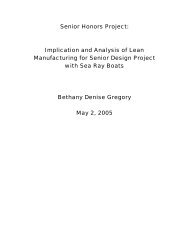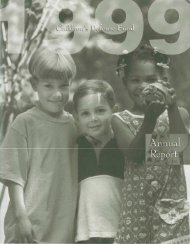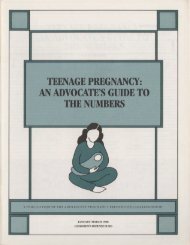child care - Digital Library Collections
child care - Digital Library Collections
child care - Digital Library Collections
Create successful ePaper yourself
Turn your PDF publications into a flip-book with our unique Google optimized e-Paper software.
THE STATE OF AMERICA'S CHILDREN YEARBOOK 1998<br />
of Pittsburgh and Allegheny County have succeeded<br />
in reducing youth violence by fostering collaboration<br />
among law enforcement officials and<br />
engaging all segments of the community in crime<br />
prevention efforts. One part of Allegheny's approach<br />
has been to convene a group of Law Enforcement<br />
Agency Directors (LEAD)-two dozen<br />
local, state, and federal law enforcement leaders<br />
who share information and collaborate. LEAD's<br />
six task forces, including a gun task force that focuses<br />
in part on those selling guns to young people,<br />
have been key to improving community safety.<br />
A second thrust involves a Youth Crime Prevention<br />
Council, initiated and chaired by the U.S.<br />
Attorney. Council members include the mayor of<br />
Pittsburgh, the county commissioner, a corporate<br />
leader, the local Catholic diocese's bishop, a foundation<br />
chair, the local Urban League chair, and two<br />
dozen other representatives from the community.<br />
The council, which focuses on implementing prevention<br />
programs, has increased the number of<br />
trained volunteer mentors, started sports leagues<br />
serving 3,200 youths each year in 12 communities,<br />
placed nearly 2,500 high school students in jobs in<br />
the private and nonprofit sectors, and established<br />
four new family support centers.<br />
Allegheny County has found that sustained coordination<br />
among different agencies maximizes the<br />
impact of individual efforts to keep <strong>child</strong>ren and<br />
communities safe. Arrests of young people for violent<br />
crime in the county plunged 30 percent between<br />
1994 and 1995, compared with a statewide<br />
decline of 9 percent.<br />
Moving Forward: A 1998 Agenda<br />
for Action<br />
The recent drop in violence by and against<br />
young people is an encouraging development.<br />
Nonetheless, far too many American <strong>child</strong>ren<br />
still crowd the justice system rather than the school<br />
system, and far too many others are haunted by<br />
fear and victimization.<br />
How can we rescue our young people from the<br />
threat-and the reality-of violence and crime?<br />
Communication is vital: advocates for youths and<br />
young people themselves must voice their concerns<br />
and put forward solutions at every opportunity.<br />
Collaboration is also key. Partnerships should be<br />
built across jurisdictions and job functions, and all<br />
segments of the community should be included.<br />
Political and civic leaders, police, prosecutors,<br />
judges, youth workers, businesses, foundations,<br />
schools, churches, and hospitals, as well as parents<br />
and young people, all have a stake in keeping <strong>child</strong>ren<br />
and the public safe, and all can make valuable<br />
contributions.<br />
In the coming year advocates should:<br />
• Emphasize prevention. Those who know that<br />
prevention works-through activities such as<br />
mentoring, after-school and summer programs,<br />
community policing, and intensive probation-must<br />
send the message over and over to<br />
policy makers and the public that prevention is<br />
the smart way to reduce violence by and<br />
against <strong>child</strong>ren. New spokespeople in the<br />
community, especially police, corrections<br />
workers, and judges, need to come forward.<br />
Greater efforts must be made to articulate the<br />
effectiveness-and the cost-effectiveness-of<br />
prevention. The National Council ofState Legislators<br />
estimates that a new juvenile prison<br />
bed costs $102,000, compared with $3,000 for<br />
an after-school slot. Advocates should continue<br />
to pound home the point, so that political<br />
leaders never fmd it easy to cut funding for<br />
prevention efforts.<br />
• Develop opportunities for young people in their<br />
out~f-school hours. Children and families in<br />
1998 need new supports to reflect the changes<br />
in the work world since 1973. After-school activities-at<br />
schools, churches, YMCAs, and<br />
other community-based organizations-must<br />
be made available. Communities must seek<br />
and create more opportunities to link <strong>child</strong>ren<br />
with caring adults and positive activities, including<br />
mentoring programs and jobs.<br />
• Replicate successful programs. The success<br />
stories in Boston, Nashville, and Allegheny<br />
County need to be replicated. Advocates<br />
should share information about what works to<br />
86 CHI L D R E 'S D E FEN S E F U D














